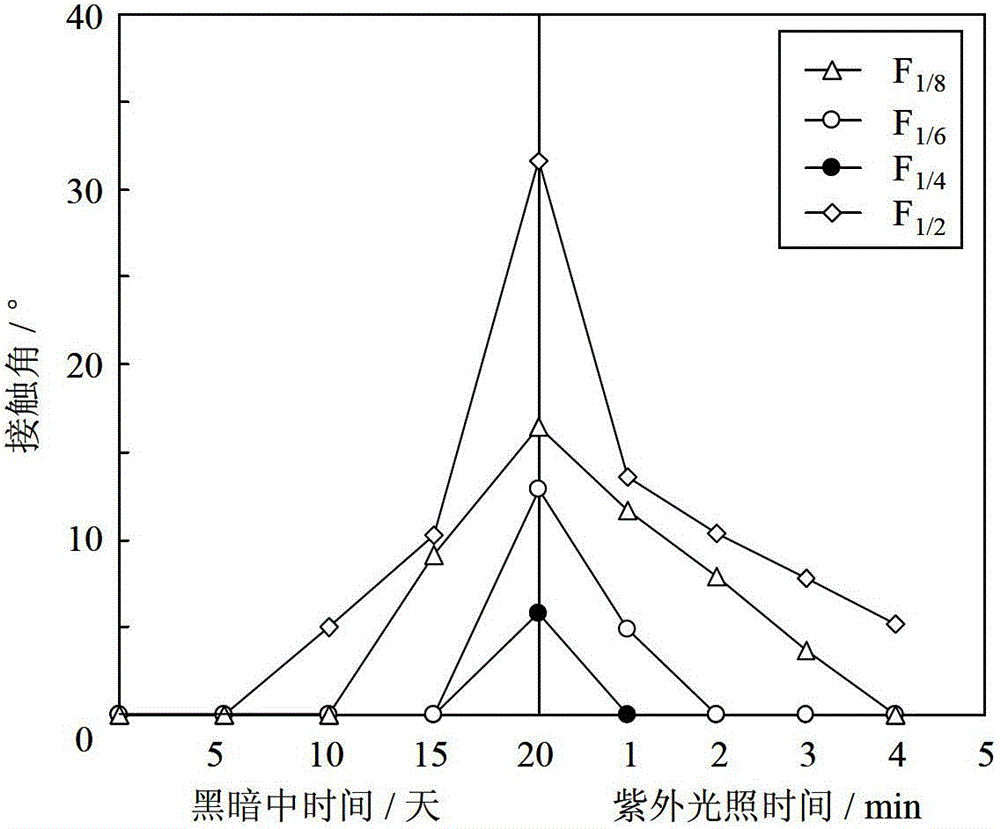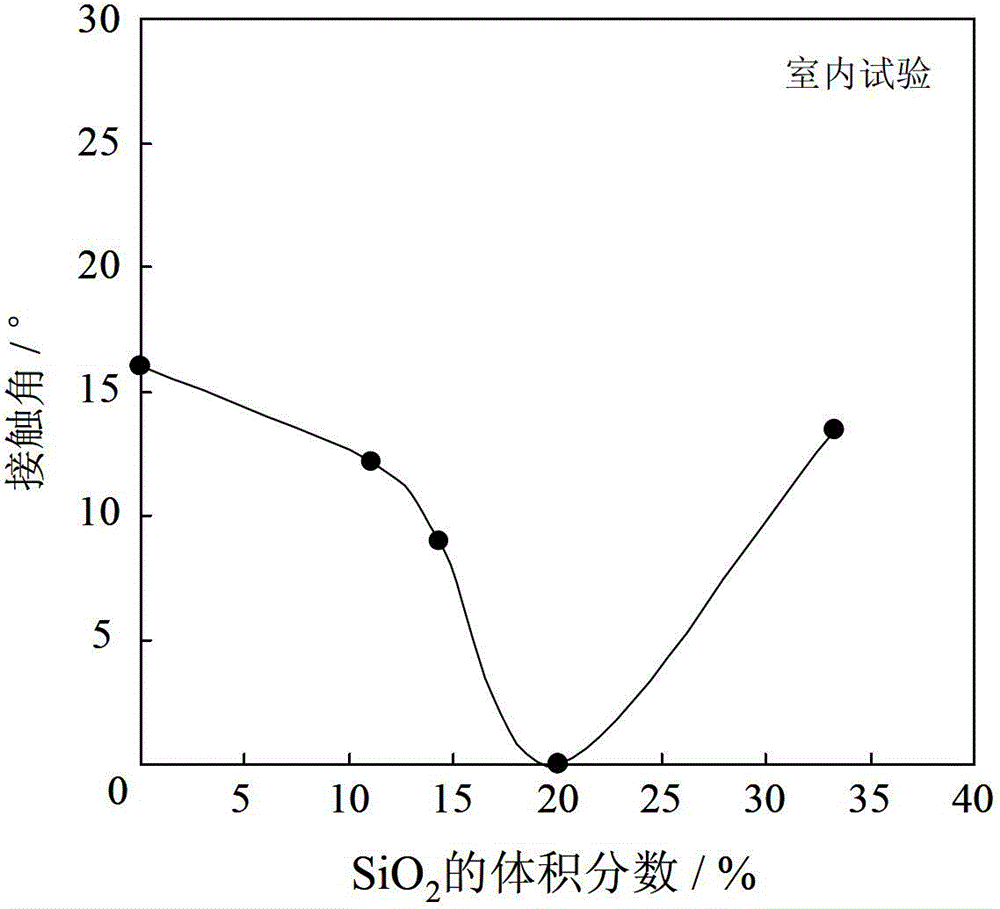Method for preparing self-cleaning antifogging coating film
An anti-fog coating and self-cleaning technology, applied in the field of thin films, can solve problems such as pollution, and achieve the effects of reducing apparent contact angle, good photocatalytic activity, and good super-hydrophilic performance
- Summary
- Abstract
- Description
- Claims
- Application Information
AI Technical Summary
Problems solved by technology
Method used
Image
Examples
Embodiment 1
[0033] 1. Nano-TiO 2 Preparation of granules:
[0034] (1) Mix 5 mL of n-butyl titanate (TBOT) with 2 mL of acetylacetone (ACAC), stir for 10 min, add 2 mL of cyclohexane, and continue stirring for 30 min to obtain solution A.
[0035] (2) Prepare 40 mL of double-distilled aqueous solution B of 800 mg / L dodecylbenzenesulfonic acid.
[0036] (3) Add solution B to solution A under magnetic stirring, and keep stirring for 20 min to obtain the emulsion of TBOT.
[0037] (4) Add 40 mL of absolute ethanol to the formed emulsion and continue stirring for 30 min to obtain a clear and transparent microemulsion.
[0038](5) Transfer the microemulsion to a reactor with a polytetrafluoroethylene inner cup, and react at a temperature of 150 °C for 24 h to obtain TiO 2 suspension.
[0039] 2. TiO 2 Film preparation:
[0040] (1) The glass substrate will be washed successively with ethanol, acetone and water, and then dried at 100°C for 30 min.
[0041] (2) Dip the dried glass subst...
Embodiment 2
[0051] 1. Nano-TiO 2 Preparation of granules:
[0052] (1) Mix 5 mL of n-butyl titanate (TBOT) with 2 mL of acetylacetone (ACAC), stir for 10 min, add 2 mL of cyclohexane, and continue stirring for 30 min to obtain solution A.
[0053] (2) Prepare 40 mL of double-distilled aqueous solution B of 72 mg / L dodecylbenzenesulfonic acid.
[0054] (3) Add solution B to solution A under magnetic stirring, and keep stirring for 20 min to obtain the emulsion of TBOT.
[0055] (4) Add 40 mL of absolute ethanol to the formed emulsion and continue stirring for 30 min to obtain a clear and transparent microemulsion.
[0056] (5) Transfer the microemulsion to a reactor with a polytetrafluoroethylene inner cup, and react at a temperature of 150 °C for 24 h to obtain TiO 2 suspension.
[0057] 2. SiO 2 Sol configuration:
[0058] (1) Add 5 mL ethyl orthosilicate to 75 mL ethanol, and stir magnetically at room temperature for 2 min to obtain ethyl orthosilicate solution C.
[0059] (2) ...
Embodiment 3
[0074] 1. Nano-TiO 2 Preparation of granules:
[0075] (1) Mix 5 mL of n-butyl titanate (TBOT) with 2 mL of acetylacetone (ACAC), stir for 10 min, add 2 mL of cyclohexane, and continue stirring for 30 min to obtain solution A.
[0076] (2) Prepare 40 mL of double-distilled aqueous solution B of 72 mg / L dodecylbenzenesulfonic acid.
[0077] (3) Add solution B to solution A under magnetic stirring, and keep stirring for 20 min to obtain the emulsion of TBOT.
[0078] (4) Add 40 mL of absolute ethanol to the formed emulsion and continue stirring for 30 min to obtain a clear and transparent microemulsion.
[0079] (5) Transfer the microemulsion to a reactor with a polytetrafluoroethylene inner cup, and react at a temperature of 150 °C for 24 h to obtain TiO 2 suspension.
[0080] 2. SiO 2 Sol configuration:
[0081] (1) Add 5 mL ethyl orthosilicate to 75 mL ethanol, and stir magnetically at room temperature for 2 min to obtain ethyl orthosilicate solution C.
[0082] (2) ...
PUM
| Property | Measurement | Unit |
|---|---|---|
| water contact angle | aaaaa | aaaaa |
| water contact angle | aaaaa | aaaaa |
| water contact angle | aaaaa | aaaaa |
Abstract
Description
Claims
Application Information
 Login to View More
Login to View More - R&D
- Intellectual Property
- Life Sciences
- Materials
- Tech Scout
- Unparalleled Data Quality
- Higher Quality Content
- 60% Fewer Hallucinations
Browse by: Latest US Patents, China's latest patents, Technical Efficacy Thesaurus, Application Domain, Technology Topic, Popular Technical Reports.
© 2025 PatSnap. All rights reserved.Legal|Privacy policy|Modern Slavery Act Transparency Statement|Sitemap|About US| Contact US: help@patsnap.com



